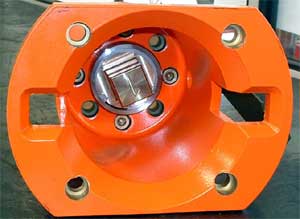Knutsford-based subsea valve specialist Oliver Valvetek, in conjunction with a major oil-and-gas operator, a subsea tree manufacturer and a subsea tooling company, has developed an innovative receptacle for operation by a remote operated vehicle (ROV) that will protect subsea valves from damage caused by the accidental application of too much torque.
The valves themselves are commonly found on what are known as Christmas trees - huge subsea installations located at approximately 10,000ft (3,048m) below sea level directly over wellheads. A great number of valves are found on such an installation, some of which are used to control chemical and additive injection into the extracted media, such as oil or gas.
However, according to Oliver Valvetek spokesperson Joel Sacca, as a result of the extreme depths at which these valves are pressed into service, they must be operated by an ROV. To do so, the arm of the ROV must enter a receptacle - an ROV docking unit - to operate the valve.
All subsea valves destined for service at such depths have such an ROV receptacle - or bucket, as they are commonly known - and these must be designed to conform to a specification known as API 17D/ ISO 13628-8.
‘[However], problems have arisen in the past because the Class 4 ROV receptacles designed in accordance with this specification allow for a maximum operating torque of 2,711Nm, which is considerably higher than the torque-to-damage limit of some subsea valves,’ explained Paul Shillito, engineering director of Oliver Valvetek.
The torque applied to subsea hardware can be set by the ROV operator. However, if this setting is not accurate, the ROV can, in theory, apply a torque far greater than the valve can tolerate.
‘Historically, the operators have used different-class receptacles for different duties, but this requires the tooling to be changed, which means bringing the ROV to the surface and, of course, carries an associated cost in terms of downtime,’ added Shillito.
To combat both the problem of damage caused by excessive levels of torque and that of costly topside retooling, Oliver Valvetek has developed a receptacle with an integral shear pin that is set to a level slightly below the torque-to-damage figure of the valve.
According to Sacca, where the new design differs from other receptacles is that, once docked, the ROV is not in direct contact with the valve. Any miscalculation regarding the amount of torque necessary to operate the valve results in the shear pin snapping as opposed to the valve spindle (an occurrence that could lead to the expensive shutting down of the tree while the valve is replaced).
‘The shear pin is housed in a retrievable cartridge that is located in the receptacle and operated via a traditional Class 4 square drive mechanism,’ said Shillito. ‘If the valve is over-torqued, then the shear pin is designed to snap before the valve can become damaged. In this eventuality, a special tool has been developed that allows the ROV to remove the cartridge and replace it with a new one housing another shear pin. All this can be done with the valve remaining in situ on the seabed.’
The cartridge is held in place by an O ring, which fits into a groove in the receptacle. ‘We’ve had to develop the geometry of the O ring groove and run tensile tests,’ he added. ‘If the configuration is too weak then the cartridge would simply fall out, but if it is too strong then the ROV may not be able to retrieve it.’
Shillito continued: ‘In the past, we have seen instances where operators have accidentally broken the spindles of needle valves on tree installations, resulting in the tree being shut down while the valve is replaced. With this system, it simply cannot happen.’

Essentially, what the company has done is to introduce a consumable item between the ROV and the valve. The tree can continue to function while the cartridge containing the shear pin is replaced, especially as the shear pin will have broken with the valve already in either the open or closed position that was desired in the first place.
Dave Wilson




Poll: Should the UK’s railways be renationalised?
The term innovation is bandied about in relation to rail almost as a mantra. Everything has to be innovative. There is precious little evidence of...